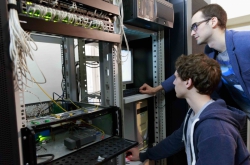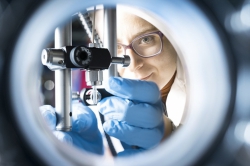Polina Poleschuk, second-year Master’s student, studies Science Communication.
Summer of 2017 – intern at Erice International School of Science Journalism
For the third time, ITMO University is participating in one of the world’s best schools of science journalism, held annually at the Erice comune in Sicily. In previous years, the school was attended by Ekaterina Boglaeva, head of ITMO’s Public Relations Office and Darya Denisova and Dmitry Malkov of ITMO’s Center for Science Communication. This year, Polina Poleschuk, a student at Russia’s first Master’s program in Science Communication, took part.

Erice, Sicily
Inspired by her colleagues’ experience, she applied for the school in early spring and was accepted in late April. Each applicant is required to submit a motivational letter and a CV. This year, the topics of discussion and lectures at the school were: citizen science, dark energy and dark matter research, “clickbait” and embargo policies in journalism, networking and many others.
“Those four days felt like a month and, at the same time, like a flash. Starting at nine in the morning, we had lectures on space journalism, overhyped headlines and the wonders of laser interferometers, discussions about media communications and predictions for the existence of alien life. The icing on the cake were the breathtaking views from the windows of a four hundred year-old church, which, unusually, served as a conference room, with the Dirac equation scribbled on the pulpit. And, of course, there were so many wonderful people from all over the world. When it came time to say goodbye to each other, we all promised each other to stay in touch,” – shared Ms. Poleschuk.
The most fascinating lectures, she says, were the ones on dark energy and dark matter; the most useful – ones about scientific communication from international students; she was also impressed when she learned about the cost of the European Southern Observatory – turns out it cost just as much as the St. Petersburg Arena stadium: a billion dollars.
“What mattered to me was that the school’s topic this year was relevant to my own work. The theme was the reflection of the latest discoveries about the Universe in mass media. My Master’s thesis focuses on a comparison of communication practices of “Roskosmos” and other leading space agencies, so when I heard about the school, I knew that I should definitely go there” – explains the student.

Participants of the Summer School in Erice.
Overall, the school attracted 35 participants from Russia, Belgium, UK, Portugal, Spain, Japan, Brazil, Chile, Italy and others. The students were invited to a magnificent location in Sicily where they could renew their knowledge of the Universe, particle physics and the latest achievements in gravity-wave astronomy.
“It’s not even about the school or the lectures or particle physics or the origins of the Universe. It’s not even about how you can have not one, not two, not even a dozen of such schools on various sciences on the same hill. The point of it is the excitement you feel when you hold in your arms a business card from a 23-year old Scotsman with the words “Colum Turner, Science Communicator” on it. It’s how happy you are when you hear Martha from Portugal tell you how they, too, drink to science. It’s how amazed you are to learn that no one was ready for the disaster at Fukushima. And you realize that, sometimes, science communication needs a good kick in the backside, be it a meteorite, a tsunami or something else,” – says Polina.

Polina Poleschuk
Grigory Shovkoplyas, fourth-year student, Computer Technologies Department
Summer of 2017 – teacher at the Summer School of IT
Summer School of IT – is a summer school for children from grades 6 to 10. The main goal of the school is to educate students about algorithmic programming and solving Olympiad tasks. This is the largest such school in Russia and neighboring countries; its graduates go on to become champions of Russian and international programming competitions.
The Summer School has two sessions – one in July and one in August. Each is attended by approximately 200 school students from Russia and other countries, ranging from beginners to experienced programmers with extensive track records. The location is a countryside resort camp: the students get to combine intensive studies with active leisure.
This year the school took place at the “Electronic” summer camp 30 kilometers away from Kostroma, in a pine forest on the shores of Volga river. Grigory Shovkoplyas, who once, too, studied there, is now a teacher there.
“One pleasant advantage that the School has over other internships is that instead of sitting in a stuffy office space, you get to spend time outside and combine studies with holidays. It’s important to me that, when I was in school, coming here gave me a much-needed push in development. It’s interesting for me to now be a teacher here and help those children like others once helped me. I think it’s interesting and useful,” – shares the student.

The Summer School has a summer camp format. Everything here is as per tradition: the kids get up early, exercise, attend assembly, have breakfast, lunch, afternoon snack and dinner. There are two study sessions every day – one after breakfast and another after lunch. After the afternoon snack, the students finish their work, take part in tournaments (both sporting and scientific), and attend courses and clubs.
“I’m a senior teacher in one of the study groups. I give most of the lectures, supervise the junior teacher and, in a way, act as their camp counsellor. Most teachers here are students, but there are some who are much more experienced than us – like Andrey Stankevich, coach of ITMO’s programming team. He is the head of the current session of the Summer School. Here, I develop as a teacher and often learn something new myself when I’m getting prepared for the lessons. There are maybe 5 other ITMO students here right now among the teaching staff,” – says Mr. Shovkoplyas.
Sergey Lepeshov, fourth-year student, Department of Light-Guided Photonics
Summer of 2016 – intern at Aston University (Birmingham, UK)

Aston University
In August 2016, Sergey went to Aston University for a two-week internship, where, supervised by Dr. Andrey Gorodetskiy, he studied the methods of terahertz spectroscopy and conducted research in nanostructured terahertz antennae on a grant given to him by the Russian Foundation for Basic Research.
“My task was to perform spectroscopic measurements of terahertz photoconductive antennae, which are the most likely candidates for use as broadband terahertz sources. To increase their efficiency, we integrated them with metal and dielectric nanoantennae. At that moment, Dr. Gorodetskiy worked with Prof. Rafailov’s research team who are known for their research in optical electronics and biomedical photonics. The team consisted mostly of scientists from Russia, so we had no trouble communicating. On the other hand, the presence of English-speaking students and staff in my group has helped me improve my English and sooner adapt to the city. Speaking of which – Birmingham, at the heart of which Aston University is situated, is the second largest city in England and a major transportation hub for UK’s well-developed railway system. This allowed me to use my free time to travel the small, but chock-a-block range of sights in the United Kingdom. The experience I gained during my internship at Aston allowed me to return to Aston University in December of the same year to continue my research and work on the development of new terahertz antennae,” – tells us Mr. Lepeshov.

Viktoria Erokhina, first-year student, Computer Technologies Department
Summer of 2017 – intern at Google’s offices in London
I wanted to spend my summer holidays on something worthwhile – to get some practice in IT and to experience working as a programmer in a large company. In January I attended an interview at Google’s office in London and from July 3 to September 22 I will intern there; my work will include working in an Android team and coding a full project of my own.
There are approximately 30 people in my team; I work a full day under the guidance of a software developer. My working process looks like this: I spend my first two weeks studying all the required material, attending lectures and getting to know everything. Once that’s done, I will begin working on my code. The goal of the project I’m working on is to provide companies an opportunity to control the distribution of applications among its employees. This is a crucial part of the Android for Work project, which is intended to help separate work applications from private ones.

Viktoria Erokhina at Google
Yuri Bondarchuk, first-year student, Computer Technologies Department
Summer of 2017 – intern at Bloomberg, London
I will work as an iOS developer at Bloomberg’s Mobile Team. The company’s main product – Bloomberg Terminal – is a computer system that allows experts in finance and other areas of industry to use the Bloomberg Professional service which lets users analyze and manage the financial market in real time mode.
There are mobile and web applications being developed for terminal owners. That product is called Bloomberg Anywhere. My task is to transfer the features of Bloomberg Terminal to the Bloomberg Anywhere mobile app.
I work under the leadership of an experienced iOS developer in a six-member team. I have a team leader and a mentor. The mentor is a person who helps me with any questions I might have. It’s really cool: I can ask whatever I want, no matter how often, and he’ll still respond and explain things to me. The internship is salaried. We had a small introductory course on using Bloomberg Terminal, and the rest we learn from the team while we work on the project.

Yuri Bondarchuk





